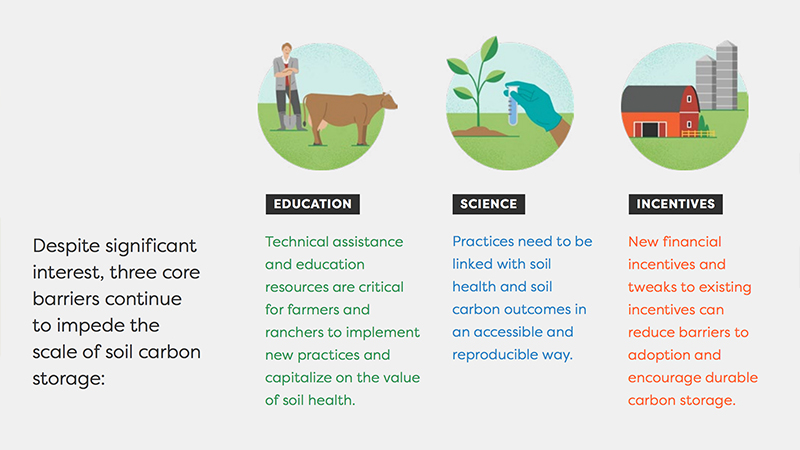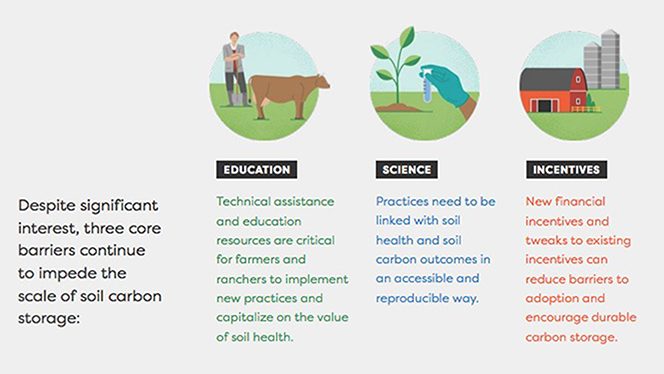The results were released recently in Leading with Soil, a report that aims to accelerate adoption of practices that store carbon by working with agricultural producers on the ground to identify and address key barriers. “Specifically, we found that despite growing interest in soil carbon storage in many states, the insufficient technical assistance, scientific knowledge gaps, and lack of strong and reliable incentives significantly hinder implementation of these agricultural practices,” states Carbon 180 in the introduction. “As a result, current adoption continues to fall short on a time and scale relevant for addressing climate change. Existing federal government programs aimed at removing these barriers, while extremely popular, are insufficient to meet the growing demand across the agriculture sector and are not explicitly focused on carbon outcomes. Fully scaling such practices will require federal support to alleviate the remaining barriers facing agricultural producers today.”
Application of compost to fields and pastures is included as a management practice for soil carbon storage. One of the policy recommendations is to fund demonstration projects such as compost application because producers are not widely familiar with these tools and/or “do not have enough confidence in the benefits of soil health practices to make long-term decisions about their operations,” notes the report. “….In the Rocky Mountains, for example, there is a need for compost trials on rangelands that vary in application rates, application timing, and grazing management.”
Leading with Soil also recommends subsidizing infrastructure to scale soil carbon storage. “The USDA should also support the creation of regional and rural compost facilities to redirect organic waste from the farm waste stream and help ensure local supply of compost. This would help resolve the logistical challenges farmers face in sourcing compost to apply to their fields and can also provide an economic development opportunity for rural communities.”
Other recommendations include:
- Solidify soil health metrics across the U.S. to make them “encompass the geographic diversity of the U.S. agricultural industry.” Existing metrics were developed by the Natural Resources Conservation Service (NRCS) in Midwestern agricultural systems and do not easily apply to dryland and irrigated systems.
- Utilize economic research to modify existing policies that disincentivize soil health practices. “For example, the current definition of ‘good farming practices’ under the Federal Crop Insurance Program does not include the full suite of NRCS soil conservation practices, making it challenging for producers implementing practices such as conservation tillage to get crop insurance. Integrating new practices into ongoing operations will require investment in infrastructure, removing existing market barriers, streamlining access to existing incentives, and providing new incentives that effectively account for soil carbon benefits.”
- Reward producers for reducing their climate risk by implementing practices that protect yields from increased instances of drought, flooding, and variable temperatures. Current premiums do not take into account the most recent data to appropriately reflect the resilience benefits of different soil health practices. “We suggest the USDA be directed to collect relevant data to make premium adjustments for producers who implement risk-reducing conservation practices. A discounted crop insurance model is being piloted in Iowa and may serve as a useful case study for broader crop insurance realignment with soil health goals. In addition, the Conservation Reserve Program (CRP) and Transition Incentive Program should expand eligibility beyond beginning and socially disadvantaged farmers to include all landowners who have land coming out of CRP. This can ensure that soil health practices that have supported the accrual of soil carbon stay in place, and we do not lose carbon that has been stored in soils.”














